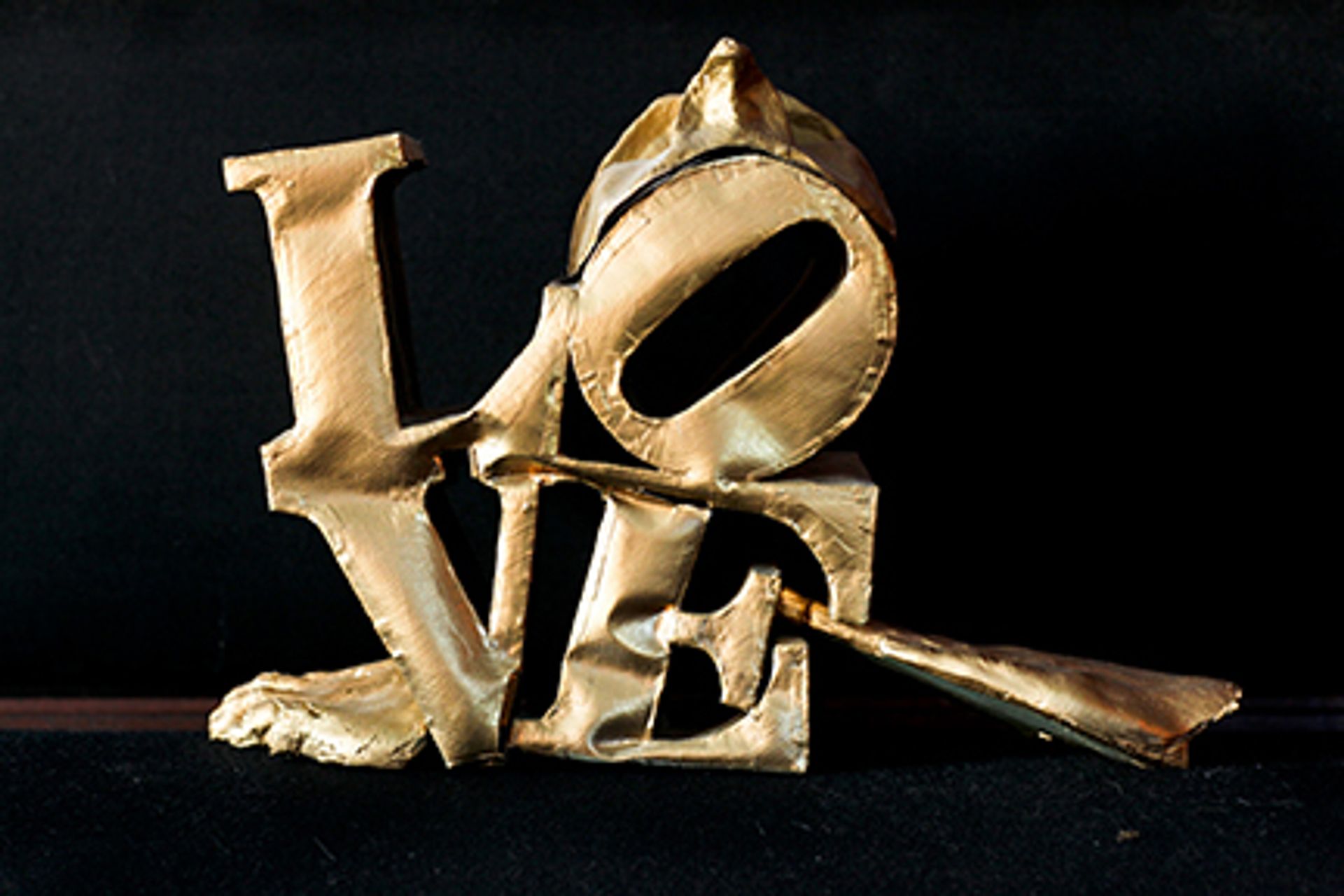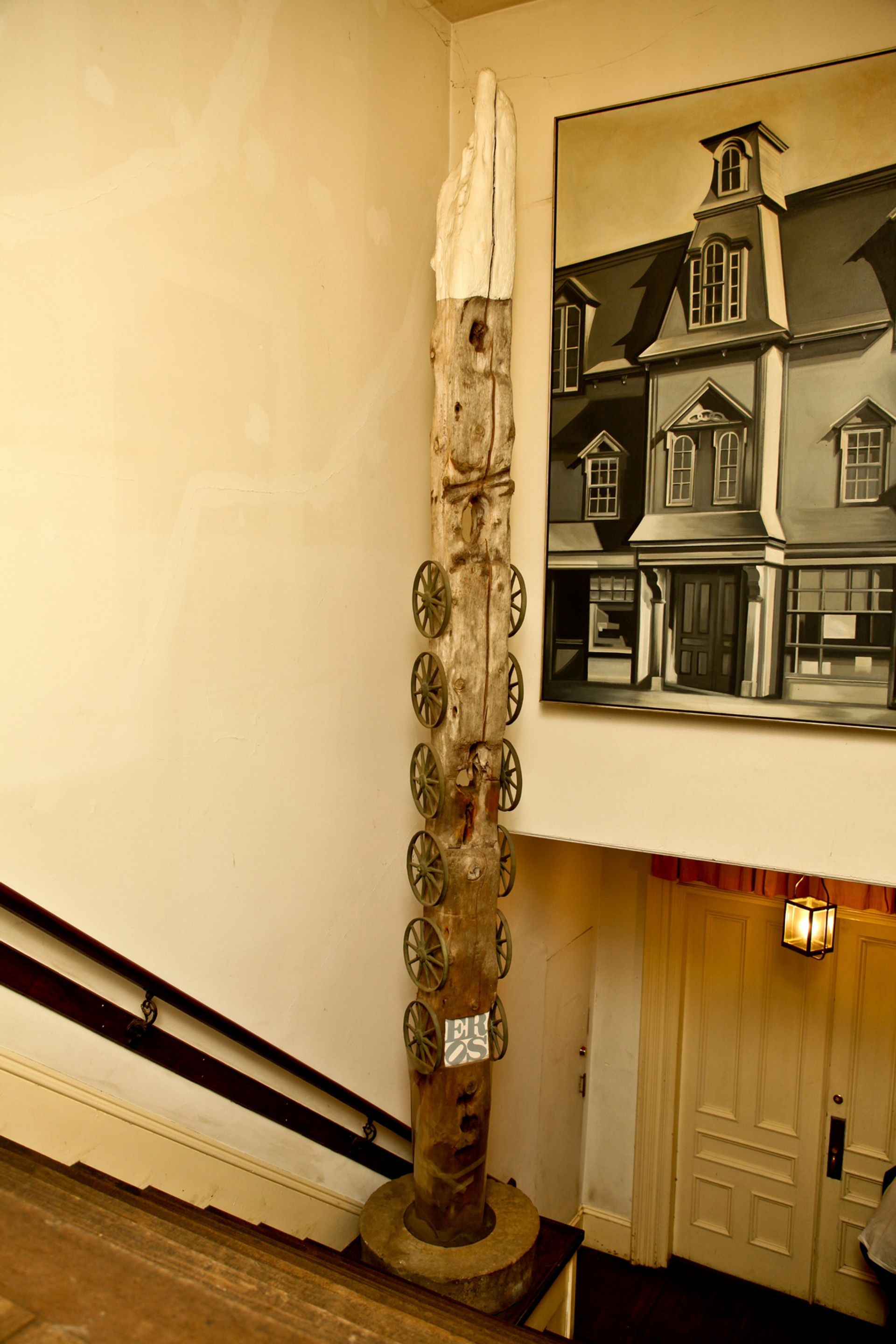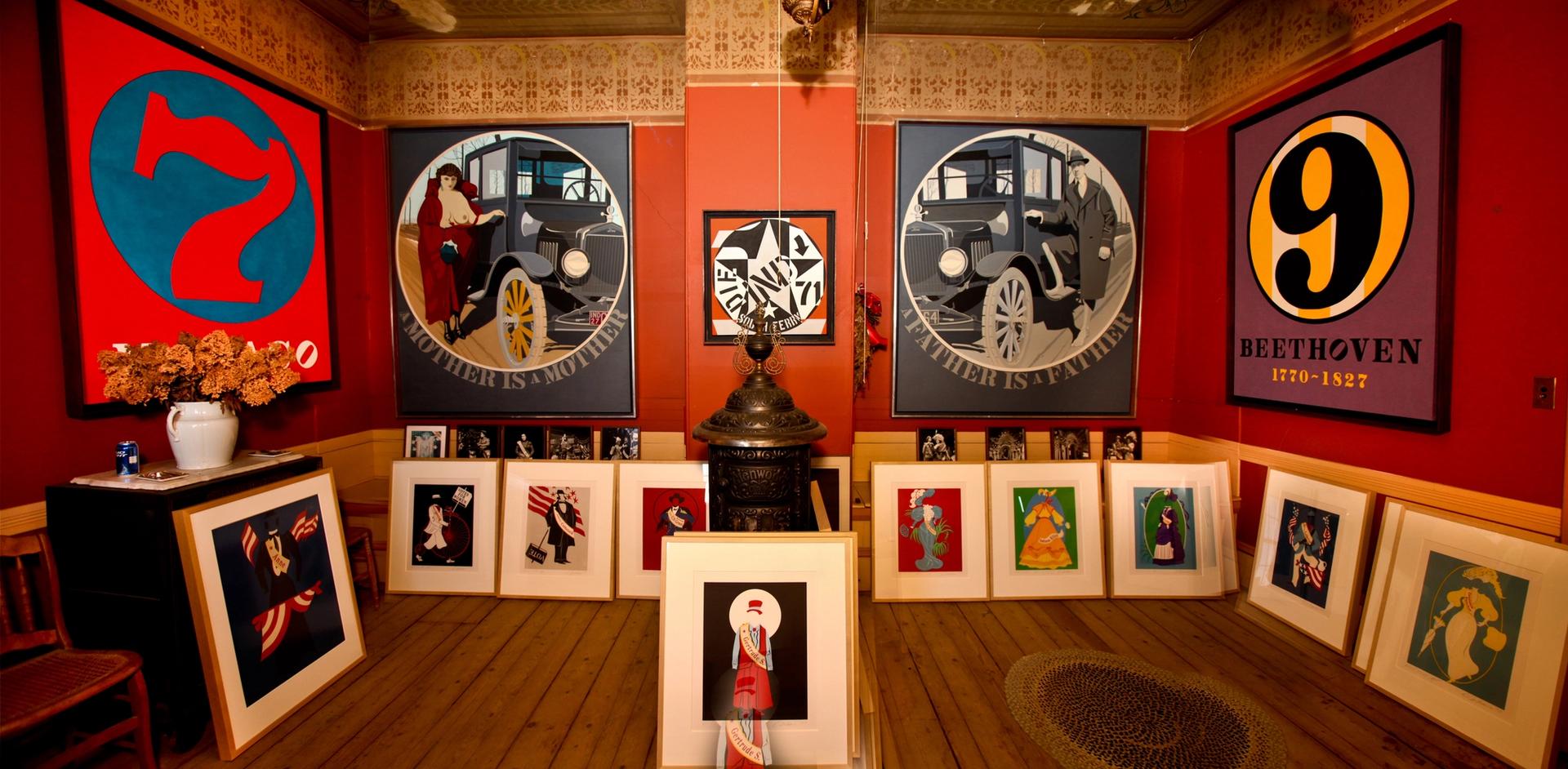In 1978, Robert Indiana permanently left New York in what he describes as “self-imposed exile”. The American artist had been “blackballed”, he says, by the New York art world, and Leo Castelli and Andy Warhol were behind it. “It started a long time ago with the Castelli gang. I have never been given a museum retrospective in New York, but all my peers have,” Indiana rued last year in a rare interview at his home on Vinalhaven, an island with a population of 1,200 people, 15 miles off the coast of Maine. Thirty-five years of estrangement came to an end last month with the opening of the retrospective “Robert Indiana: Beyond Love”, at the Whitney Museum of American Art (until 5 January 2014).
The New York show is a homecoming in more ways than one; it also marks a return to critical favour for the 85-year-old artist, who has lacked serious art historical assessment since holing up on Vinalhaven. He has, however, enjoyed commercial success over the past ten years, particularly with his sculptures. The annual turnover for Indiana’s art at auction in 2012 was $13.5m compared with $1.3m in 2002, according to Artprice, with sculpture accounting for 60% of sales and painting 36%. Countless other works have also been sold through galleries.
For most commentators, the disparity between Indiana’s selling power and his critical reception can be explained in four cherry-red capital letters: L-O-V-E. First created in 1965 for a Museum of Modern Art Christmas card, Indiana’s famous “Love” design was never copyrighted and has since appeared on everything from coffee mugs to number plates—with barely a cent going to Indiana.
Robert Storr, the dean of the Yale University School of Art, says “Love” was a “disaster” for the artist: “It has overshadowed absolutely everything else he has done.” Paul Kasmin, Indiana’s art dealer in New York since 2002, is a little more sanguine, describing the work as “a mixed blessing”. Indiana, meanwhile, is ambivalent. “‘Love’ cinched my whole career, it put me on the map,” he says. “But, it has also caused me grief and unhappiness, rip-offs and endless unpleasantness.”

“‘Love’ is embedded in the public consciousness, it doesn’t need to be reiterated,” says Barbara Haskell, the curator of the Whitney retrospective Photo: JOEL GREENBERG
Its ubiquity led Barbara Haskell, the curator at the Whitney, not to include any signature red “Love” sculptures in the New York retrospective. “‘Love’ is embedded in the public consciousness, it doesn’t need to be reiterated,” she says, pointing out that one is installed in Midtown, not far from the Whitney. In London too, Waddington Custot Galleries have installed a version of “Love” as part of the outdoor programme, “Sculpture in the City” (until May 2014). Haskell has opted instead for The Electric LOVE, which was conceived in 1966 and realised in 2000, as well as two painted versions from the 1960s.
The omission has caused a stir in the commercial world. Kasmin says the exhibition should not be called a retrospective as, not only is “Love” absent, Indiana’s “Hope” and “Numbers” sculptures are also missing. The exhibition covers 1954 to 2004, but Indiana first created his “Hope” design for Barack Obama’s presidential campaign in 2008, boosting Obama’s coffers by $1m. Kasmin says the Whitney’s decision not to include the “iconic” works did not come as a shock to Indiana: “He is generally a pessimist and is not surprised by anything anymore.”
A heated market for Pop art has also contributed to a demand for Indiana’s sculptures. Interest peaked in May 2011 when the 12ft Love red/blue, 1990, sold at Christie’s New York for a record $4.1m. But Indiana has always fiercely rejected the Pop artist mantle, despite being affiliated with the group in the 1960s. “I was surrounded by Pop artists, New York was infested [with them],” Indiana says. “But I was a hard-edged formalist, that’s not Pop.”
Instead, Indiana skulked on the darker peripheries of the movement. He rarely visited Warhol’s Factory, but in 1964 he starred in Warhol’s Eat, a 40-minute black-and-white silent film of Indiana eating a mushroom. Indiana recalls the power play between them. “I starved myself the day before filming and turned up for the shoot with a whole table-full of delicious things to eat,” he says. “But Andy comes in and picks up one mushroom and he says he wants me to eat it. The whole film is [me] eating that mushroom.” However, all was not as it seems. “We did cheat,” Indiana says. “It wasn’t just one mushroom, although it was supposed to be one mushroom… I can’t tell you [how many I ate], that wouldn’t be nice. I don’t want Warhol turning in his grave.”
Rather than Pop, Indiana pegged himself to the geometric abstraction of Ellsworth Kelly, who he met in New York in 1956. But as Storr points out, their type of painting did not gain solid footing among critics for several decades. “Even Kelly was not given the proper attention he was due until around 15 years ago,” Storr says. Indiana’s return to the spotlight is “part of a perfectly normal generational sifting, sorting and cementing of reputation”. Momentum is building: the first survey of Indiana’s graphic prints since 1969 is due to open at the Indianapolis Museum of Art next February and “Signs from the Sixties: Robert Indiana’s Decade” opens at the Currier Museum of Art in New Hampshire next month.
Indiana’s rejection of Pop art was reciprocated in 1969 when he was left out of the exhibition, “New York Painting and Sculpture: 1940-1970”, at the Metropolitan Museum. The show, organised by Henry Geldzahler, then the curator of American art, consisted of a highly personal selection of 408 works by 43 artists, but its influence was far reaching. Storr cites the exclusion as a turning point in Indiana’s career. “It was a very peculiar list and some people were left out who should have been in, including Bob,” Storr says. “It was a big item, the Pop generation was really sorted out then.”

A sculpture with the word EROS in Robert Indiana's Vinalhaven home Photo: JOEL GREENBERG
Memories of Americana
If, by 1969, Indiana had begun to fall from grace in the New York museum world (he had been the art world darling at the start of the decade when Alfred Barr bought The American Dream I, 1961, for the Museum of Modern Art), European institutions and collectors were still buying his work. The Museu Colecção Berardo in Lisbon, the Van Abbemuseum in Eindhoven and Cologne’s Ludwig Museum are among the lenders to the Whitney show. To a European eye, Indiana’s art appeared particularly American, with its visual references to highway signs and roadside diners, as well as its literary references to Walt Whitman and Herman Melville. “It summoned up old memories of Americana,” Storr says.
Indiana has attracted a dedicated following in France. According to Artprice, between 1999 and 2012, 32% of all transactions for Indiana’s work took place in France, second only to the US (37%), and above the UK in the third spot with 9.2%. French museums have also lent their support through exhibitions. Indiana’s last museum retrospective was at the Musée d’Art Moderne Contemporain in Nice in 1998. He was due to have another at the Grand Palais in Paris last November, but the show was cancelled at the last minute after a private backer pulled out. There were rumours that the real reason for the cancellation was because more than one third of the exhibition came from a private collection, breaking an unwritten rule in public institutions in France. It is thought that taking a group of works from a single private collector would unfairly raise their commercial value. However, no one could confirm this was actually the case at the Grand Palais.
The European market for Indiana’s work is still buoyant, and not just for the familiar pieces. A selling exhibition of his little-known wooden assemblages, which he created over five decades until the mid-2000s, opened at Galerie Gmurzynska in Zurich this summer, where two large-scale pieces sold (though the gallery would not say for how much). The sculptures, which Indiana calls “herms” after the ancient Greek pillars used to mark boundaries, typically sell for between $500,000 and $2m; a 1960 assemblage sold at Sotheby’s New York last November for $542,500. The Whitney retrospective also features 23 early wooden works, with one third on loan from public museums.
Indiana started to make his wooden sculptures in 1956 when he moved with Ellsworth Kelly to Coenties Slip, then an artists’ enclave in Lower Manhattan. With little money for materials, Indiana turned to the objects and images he found lying around. “I couldn’t afford canvases, the Abstract Expressionists were working too large, so I went out and found junk wood from the demolition sites,” Indiana says. “My work really started there, with little pieces of wood.” Although aesthetically distinct, the herms are in many way precursors to the rest of his output—it was while working on these wooden assemblages that Indiana first introduced words to his work. Mathias Rastorfer, the director of Galerie Gmurzynska, describes them as “the defining works of the real Robert Indiana”.
While their artistic relationship is well documented, Indiana never flaunted his sexual relationship with Kelly. “[In New York] I was out to some but not to others,” he said in an interview with Art in America in 2008. Indiana says he and Kelly eventually fell out because of “various levels of jealousy”—Kelly was unhappy that Cy Twombly was painting in Indiana’s studio at Coenties Slip, but Indiana doesn’t elaborate. “Men in Indiana’s generation didn’t hide who they were but they didn’t broadcast it either,” Robert Storr says, noting that an “overt queering of art history” by a younger generation of historians, and a reading of Indiana’s art as coded expressions of homosexuality, have contributed to his current critical resurgence. “The older generation alluded to but were more discreet about the gay and lesbian subtexts of art,” Storr says.
Whether or not Indiana engaged with gay politics in his work, he was vociferous in his criticism of American politics at large, particularly in terms of the civil rights movement. His “Confederacy” series of paintings from 1965-66, a comment on racial injustice in the American South, are on show at the Whitney. Indiana had meant to create a painting for each of the 13 secessionist states, but only completed four, targeting Alabama, Mississippi, Louisiana and Florida. “These paintings are very blunt and scathing,” Barbara Haskell says. “In the context of the 1960s, they are far more bold than what other artists were doing.”

Robert Indiana created the work HOPE for Barack Obama's election campaign Photo: JOEL GREENBERG
Unafraid of politics
Indiana lights up when talking about his political works. “This one could have got me thrown into jail,” he says, pointing to The Golden Future of America, 1976, a painting with three eyes in the centre that stand for the letter “I” in CIA, FBI and IRS. “This one set Nelson Rockefeller's teeth on edge and so I never became a part of his collection,” Indiana says, referring to A Divorced Man Has Never Been the President, 1961. Rockefeller fatally undermined his bid for the presidency when, in 1962, he divorced his wife of 31 years, only to remarry a woman 27 years his junior in 1963. It is appropriate, then, that Indiana was involved in Barack Obama’s 2008 presidential campaign, although the artist told The Art Newspaper that he wouldn’t be voting for the US president again during the re-election. “I’m disappointed,” he says quietly.
Strip back the politics, though, and at the heart of Indiana’s work lies his biography. A younger generation of critics such as Alison Unruh, Jonathan Katz and Kalliopi Minioudaki are discovering these threads, which has contributed to the sea change in critical reception. Mother and Father, 1963-66, a little-known figurative diptych in the artist’s collection that alludes to the fact that Indiana was adopted as a baby, takes centre stage in the Whitney exhibition to “signal that this is a different kind of show”, Haskell says. But just as he changed his name from Robert Clark to Robert Indiana on the eve of his 30th birthday in 1958, his life stories are often as much of an invention as his art. As Unruh says in the exhibition catalogue: “His self-mythology is one of his greatest creations. It’s an epic story.”
And what of the man who removed himself from the world in 1978? The former Oddfellows (friendship group) lodge where Indiana lives is a dark, rambling building, called the Star of Hope, that was built in the 19th century. The lodge has become a museum of the artist’s work and life (Indiana has kept a major work from every year of his career), and houses a vast, meticulously kept archive of photographs, exhibition posters and documents. Last year, he told The Art Newspaper that the Farnsworth Art Museum in Rockland, Maine would probably inherit his collection. “They have been kinder to me than anybody in New York,” he said. Kindness aside, the artist has finally been granted his New York retrospective. Perhaps, after all, Robert Indiana will leave something to the city where he made his name.

Work kept at Robert Indiana’s home in Vinalhaven, Maine, where he maintains an extensive archive Photo: JOEL GREENBERG
***
Biography: Robert Indiana
Born: Robert Clark, New Castle, Indiana, 13 September 1928
Education: The Art Institute of Chicago, 1949-53; Skowhegan School of Painting and Sculpture, Maine, 1953; Edinburgh University and Edinburgh College of Art, 1953-54
Lives and works: Vinalhaven, Maine
Represented by: Paul Kasmin, New York; Galerie Gmurzynska, Zurich, Zug and St Moritz
Selected exhibitions: 2013 “Robert Indiana: Beyond Love”, Whitney Museum of American Art, New York (until 5 January 2014); 2012 "Robert Indiana: Sculptures", Waddington Custot Galleries, London; 2009 "Robert Indiana and the Star of Hope", Farnsworth Art Museum, Rockland, Maine; 2008 "Hard Edge", Paul Kasmin Gallery, New York; 2005 "Wood", Paul Kasmin Gallery; 2003 "Recent Paintings", Paul Kasmin Gallery; 1998 Retrospective at the Musée d'Art Moderne Contemporain, Nice; 1982 "Indiana's Indianas: A 20-year Retrospective of Paintings and Sculptures from the Collection of Robert Indiana", Farnsworth Art Museum


